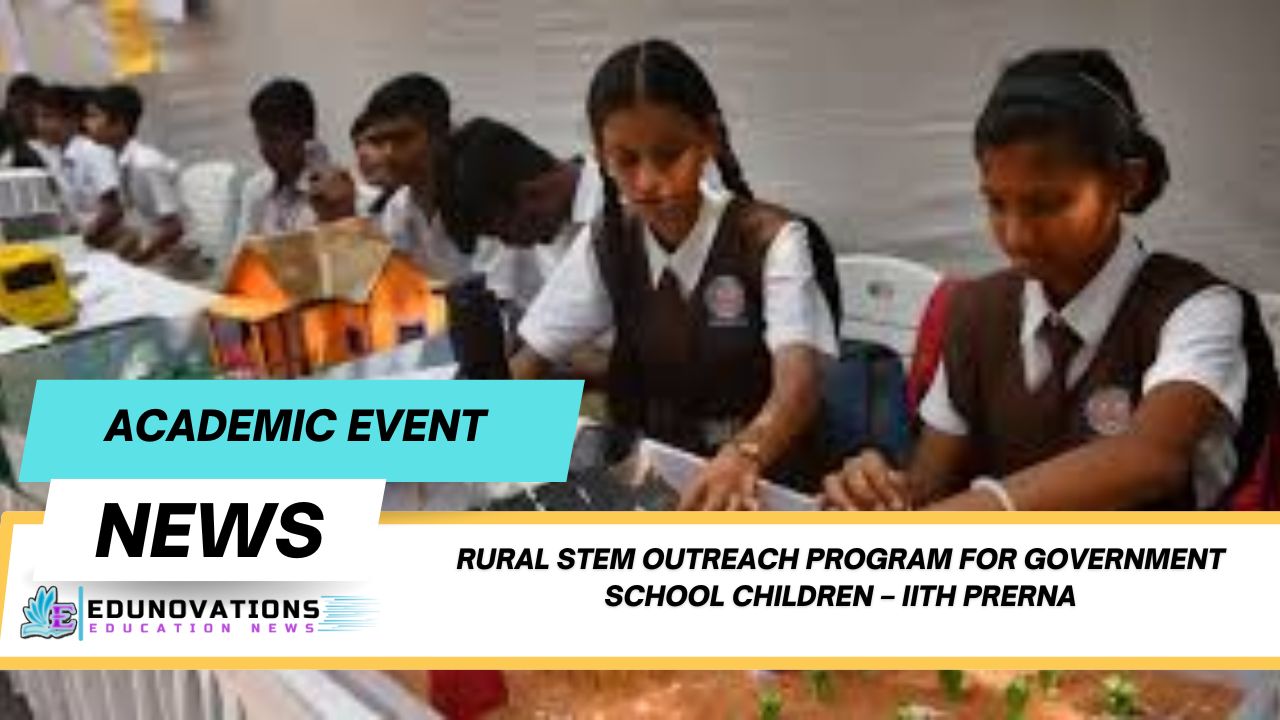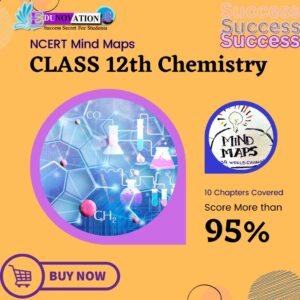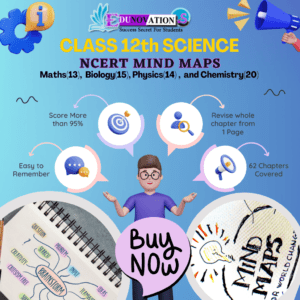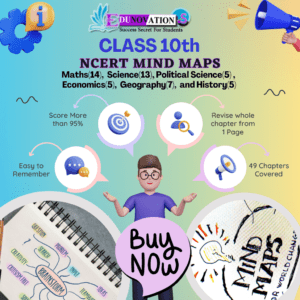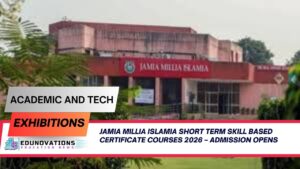Discover how IITH’s rural development centre and Prayas launched a life-changing STEM outreach program for government school children through the Prerna initiative.
Introduction
The Rural Development Centre (RDC) of the Indian Institute of Technology Hyderabad (IITH), in collaboration with its student-led outreach group Prayas, organized Prerna-2025, a transformative event bringing rural STEM outreach program for government school children to life. This flagship initiative aimed to inspire over 500 students, parents, and teachers from nearby Zilla Parishad High Schools (ZPHS) to envision higher education and career opportunities through science, technology, and community support.
Held on the IITH campus, Prerna-2025 combined motivational talks, hands-on STEM experiences, interactive parent sessions, and a full tour of the institute. The event reinforced the IDC’s mission to uplift rural communities by connecting education, skilling, and empowerment.
The Vision Behind Prerna-2025
Fostering a Rural STEM Outreach Program for Government School Children
At the heart of Prerna-2025 lies IITH’s vision of rural empowerment through education. The RDC was established in July 2020 with a broad mandate to support rural communities via innovative technologies. RDC IITH+1 Prerna is one of its most ambitious educational outreach efforts.
Prerna was conceptualized to:
- Boost rural aspirations – motivate students from under-resourced government schools to pursue higher studies.
- Strengthen parent engagement – involve parents in understanding the value of education and long-term skill-building.
- Expose students to STEM – give real exposure to labs, experiments, and academic life at a premier institute.
- Promote community empowerment – highlight skilling and education as central pillars for rural growth.
What Happened During Prerna-2025
Student Participation & Campus Tour
More than 500 children, parents, and teachers from ZPHS schools in Kandi, Indrakaran, Cheriyal, Yeddumailaram, Kalivemula, and other villages attended the program.
- Students were given a guided tour of IITH’s academic buildings, laboratories, and research facilities.
- In labs such as the physics department, they saw real demonstrations — for example, light dispersion via prisms — sparking curiosity and wonder.
- They interacted with faculty, researchers, and student mentors, helping demystify the world of STEM and showing a pathway to higher education.
Motivational Talks and Guidance
The event featured a series of inspiring talks:
- Prof. B. S. Murty, Director of IITH, emphasized how the institute’s mission aligns with uplifting rural talent, building confidence, and nurturing long-term aspirations.
- High-profile speakers, including IAS, IPS, and IRS officers, shared their personal journeys — often rooted in humble beginnings — to encourage the students and their parents.
- Dr. Sri Rama Chandra Murthy Machiraju, founder of Aksharaan, addressed the parents, underlining that their support and encouragement are key to shaping their children’s futures.
Parent Engagement and the “Deeksha” Program
A core component was Deeksha, a career-readiness initiative jointly run by RDC and Prayas.
- Exams were administered for students in classes 7, 8, and 9 from six ZPHS schools.
- Based on performance, two students per grade per school were selected to return to the campus for future programs — a recognition of talent and potential.
- Parents attended a dedicated session emphasizing lifelong learning, and how their backing can positively influence their children’s academic and professional trajectories.
Hands-On STEM Experience
One of the most engaging parts of the program was the hands-on STEM workshop, where:
- Students experienced a physics lab experiment involving prisms and light, helping them grasp fundamental scientific concepts in a fun, tangible way.
- The exposure bridged the gap between theory taught in classrooms and real-world scientific investigation, providing a taste of what engineering or physics education could look like at a higher level.
Why This Rural STEM Outreach Program Makes a Difference
Building Confidence Through Exposure
By bringing rural students and their families onto the IITH campus, the Prerna initiative breaks down psychological and geographical barriers. For many students, this may be the first time they step inside a world-class research institute — and that exposure can be transformative. Researchers call this “aspirational uplift” — seeing what’s possible helps students believe in their potential.
Empowerment via Parent Involvement
The decision to include parents is a strategic masterstroke. In many rural settings, parental beliefs significantly influence whether a child continues with education. When parents hear from accomplished individuals about the value of learning, they become more invested in their children’s education pathways.
Encouraging STEM in Rural Education
Hands-on STEM workshops, campus tours, and lab interactions serve more than a motivational purpose. They:
- Spark curiosity in science and technology fields
- Help students visualize STEM careers
- Provide a real sense of research and innovation as not just distant ideals, but accessible goals
Creating a Long-Term Support System
With programs like Deeksha, RDC and Prayas are not just running a one-day event — they are building a talent pipeline. Students selected through the Deeksha exam will likely benefit from continued mentoring, possibly scholarships or advanced programs, and further visits. This long-term engagement helps:
- Track students’ academic journey
- Provide resources and guidance tailored to rural students
- Strengthen community bonds with IITH and alumni
Beyond Prerna: The Bigger Picture of Rural Empowerment
Prerna-2025 fits into a broader strategy that IITH’s RDC is driving, focusing on education, environment, and entrepreneurship. Some other key aspects:
- Skilling Centre Launch
- IITH’s RDC has inaugurated the NBV Skilling Centre, aimed at rural and semi-urban youth.
- The center is part of a collaboration between IITH, Next Bharat Ventures (Suzuki), and the Deshpande Foundation.
- It offers soft and technical skill training, entrepreneurship modules, and real-world innovation challenges.
- Through the Next Bharat Skilling Foundation (NBSF), the center aims to train over 50,000 youth and benefit an equal number of school students by 2035.
- Continued Rural Education Engagement
- Prayas, the student wing under RDC, regularly visits ZPHS schools in six villages: Kandi, Indrakaran, Kalivemula, Cheriyal, Yeddumailaram, Mamidipally.
- Volunteers from IITH tutor subjects like Mathematics, Physics, Chemistry, Biology, and English — strengthening the regular school curriculum.
- The aim is also to instill a culture of curiosity and scientific temper through extra classes, mentorship, and hands-on projects.
- Innovation + Social Impact
- The RDC also works on broader rural challenges: sanitation, water quality, and rural supply chain modernization.
- In its 2023–24 annual report, IITH shared that vending machines were installed in multiple villages to make essential goods easily available, and women from those villages were trained to operate and manage them.
Expert Insights
To understand the impact of such a rural STEM outreach program for government school children, I spoke with Dr. Satish Regonda, Chairperson of the RDC at IITH. He said:
“Prerna is not just an outreach event — it’s a bridge. A bridge that connects rural curiosity with academic excellence, that connects parents’ dreams with students’ ambitions. When a child from a village visits our labs or talks to our professors, that becomes a turning point.”
He emphasized that follow-up matters: “It’s not enough to inspire — we must mentor. Through Deeksha and further involvement, we build a support system so students don’t just dream, they act.”
Education policy experts also note that long-term rural engagement by premier institutes can reduce rural–urban migration. When young people see value in education and local opportunity, they are less likely to leave their villages, strengthening rural economies and community resilience.
Challenges & the Road Ahead
While Prerna-2025 is a landmark effort, scaling such programs has its challenges:
- Sustained Funding: Large-scale outreach and mentorship need constant investment. Partnering with NGOs and corporations (as done for the NBV Skilling Centre) is promising, but such collaborations must be maintained and expanded.
- Tracking Impact: It’s critical to track the academic progress of students selected through Deeksha and continue supporting them. Without follow-up, momentum may fade.
- Local Infrastructure: Some rural schools may lack basic infrastructure (e.g., labs, reliable electricity), limiting how much hands-on STEM can be delivered locally.
- Parental Constraints: Even with motivation sessions, many families may face financial or logistical challenges in supporting long-term education.
But IITH’s RDC seems cognizant of these obstacles. Their holistic model — combining outreach, skilling, and technology — is designed not just for short-term inspiration, but sustainable change.
Why Other Institutions Can Learn from This Model
IITH’s approach through Prerna-2025 and the broader RDC strategy offers a blueprint for other universities and colleges that aim to:
- Embed Rural Education into Institutional Missions
By institutionalizing outreach (through an RDC), the work becomes part of long-term planning rather than ad-hoc CSR. - Leverage Student Power
Student volunteer networks like Prayas can effectively act as mentors, role models, and connectors — bringing relatability and energy to outreach. - Promote STEM Through Experience
Campus visits, lab demonstrations, and hands-on experiments make STEM tangible and exciting — particularly for students who may never have seen a university lab. - Engage Families, Not Just Students
Parental buy-in is critical. Events that involve parents reinforce the value of education in the family structure. - Link Education with Skilling
By combining educational motivation (Prerna) with skills training (NBV Skilling Centre), the model addresses both aspiration and employability.
Conclusion
The rural STEM outreach program for government school children embodied in IITH’s Prerna-2025 isn’t just a motivational event — it’s a catalyst for change. By coupling inspiration with real exposure, meaningful parent engagement, and long-term follow-up, the initiative builds a pipeline for rural talent to dream big, learn deeply, and contribute meaningfully.
As IITH’s RDC and Prayas continue their work, the vision of rural empowerment through education, employment, and innovation becomes more than an ideal — it becomes a living, growing reality.
Toppers Use Mind Maps to score more than 95%
NCERT Class 11th Commerce Mind Maps
Add to cartOriginal price was: ₹999.00.₹199.00Current price is: ₹199.00.NCERT Class 12th Chemistry Mind Maps
Add to cartOriginal price was: ₹199.00.₹75.00Current price is: ₹75.00.NCERT Class 12th Commerce Mind Maps
Add to cartOriginal price was: ₹999.00.₹199.00Current price is: ₹199.00.NCERT Class 12th Science Mind Maps
Add to cartOriginal price was: ₹999.00.₹199.00Current price is: ₹199.00.NCERT Mind Maps For Class 10th
Add to cartOriginal price was: ₹999.00.₹199.00Current price is: ₹199.00.
Purchase Today
FAQs
- What is the rural STEM outreach program for government school children by IITH?
It is a flagship initiative called Prerna-2025, organized by IITH’s Rural Development Centre (RDC) and student group Prayas, designed to motivate and expose rural students and their parents to higher education and STEM fields. - Which schools participated in the Prerna-2025 event?
Students and parents from Zilla Parishad High Schools (ZPHS) in villages like Kandi, Indrakaran, Cheriyal, Yeddumailaram, Kalivemula, and Mamidipally joined the program. - What kind of hands-on activities were part of the IITH Prerna event?
Students visited academic labs, observed physics experiments (such as light dispersion through prisms), and interacted with professors and student mentors. - How does the IITH Prerna event involve parents in rural education empowerment?
Parents attended motivational talks by experts, engaged in career-readiness discussions, and learned about the long-term importance of education in their children’s lives. - What is the Deeksha program in relation to Prerna-2025?
Deeksha is a career-readiness exam for students in grades 7 to 9. Selected students (two per grade per school) get further mentoring and support, strengthening the outreach’s long-term impact. - How does the IITH rural empowerment through education strategy extend beyond Prerna?
Beyond Prerna, IITH’s RDC runs a skilling center (NBV Skilling Centre), regular tutoring sessions in government schools, and innovation-based rural projects. - What is the NBV Skilling Centre mentioned in relation to IITH’s rural initiatives?
It’s a skill development hub launched by IITH’s RDC in partnership with Next Bharat Ventures (Suzuki) and the Deshpande Foundation, focusing on soft and technical skills for rural youth. - How does IITH’s Prayas group support rural students long term?
Prayas volunteers tutor in ZPHS schools in subjects like Maths, Physics, Chemistry, Biology, and English. They also mentor students through programs like Deeksha. - What broader goals does IITH’s RDC aim to achieve through these educational efforts?
RDC’s mission centers on education, employment, and empowerment, striving to reduce rural–urban migration, improve local infrastructure, and build sustainable opportunities in rural areas. - Why is this rural STEM outreach program significant for India’s future?
It democratizes access to quality education and skills, uplifts marginalized communities, nurtures future innovators, and strengthens social and economic inclusion at the grassroots level.

